Dry anaerobic digestion can be seen as a well-kept secret. It is seldom mentioned in most AD industry circles.
Yet it is already an established technique for reducing the organic activity of MSW (Municipal Solid Waste) to make it less of a problem when landfilled. And, it is now poised to push into traditional CSTR feedstock markets.
The process does also produce biogas but in general, there may be less of it than from wet-AD.
In the rush to develop anaerobic digestion plants until about 2015, most biogas project promoters stuck to the most familiar methods of wet anaerobic digestion. That resulted in complex processes to remove the organic content. The ArrowBio company, for example, is a master of this technology and has been designing and building wet AD plants for mixed (black bag) MSW for over 20 years (as of 2021).
To use a CSTR (Continuously Stirred Tank Reactor) you need to add water. A lot of it.
For municipal waste purposes where the digestate will not be suitable for use as a fertilizer using the wet-digester (pumped fluid slurry) technology available until now, is expensive. It means disposing of the added water as liquid digestate. That will be at least a problem and most likely a very expensive additional waste for disposal.
Also, in many countries, the profitability of biogas projects depends on efficiently utilising the dry organic feedstocks which others cannot accept. Adding water in order to pump the resulting mash of solids and liquid makes no sense for such high-solid material dry wastes.
For both types of waste, especially if the ultimate disposal of the residue will be to landfill, dry anaerobic digestion can be the solution. If anyone misses this point and embarks upon a wet AD project, Dry Anaerobic Digestion may just be the secret they wish they discovered first!
Dry Anaerobic Digestion of MSW (Municipal Solid Waste) Organic Fraction
One of those feedstocks is the organic content of household waste. Alternatively known as MSW (Municipal Solid Waste) organic fraction.
Those businesses that send their “easy to digest” feed materials to the most common AD reactor systems, Continuously Stirred Tank Reactors (CSTRs), are getting wiser. They are rapidly becoming aware that their waste has value. Dry AD systems may help them process their wastes in-house to benefit from that value.
These companies with organic waste suitable for AD plant use, won't be slow to start demanding higher prices for their organic waste output to be taken away, as time goes on and more AD plants are commissioned.
Therefore, as waste feed materials become more sought after, we contend that there are some very valuable Dry Anaerobic Digestion secrets out there that extend the range of digestible biogas feedstocks.
In particular, value can be gained from solid organic waste, including the organic fraction of household waste (Municipal Solid Waste). Companies such as Kompogas even have an innovative continuous Dry AD technology to offer.
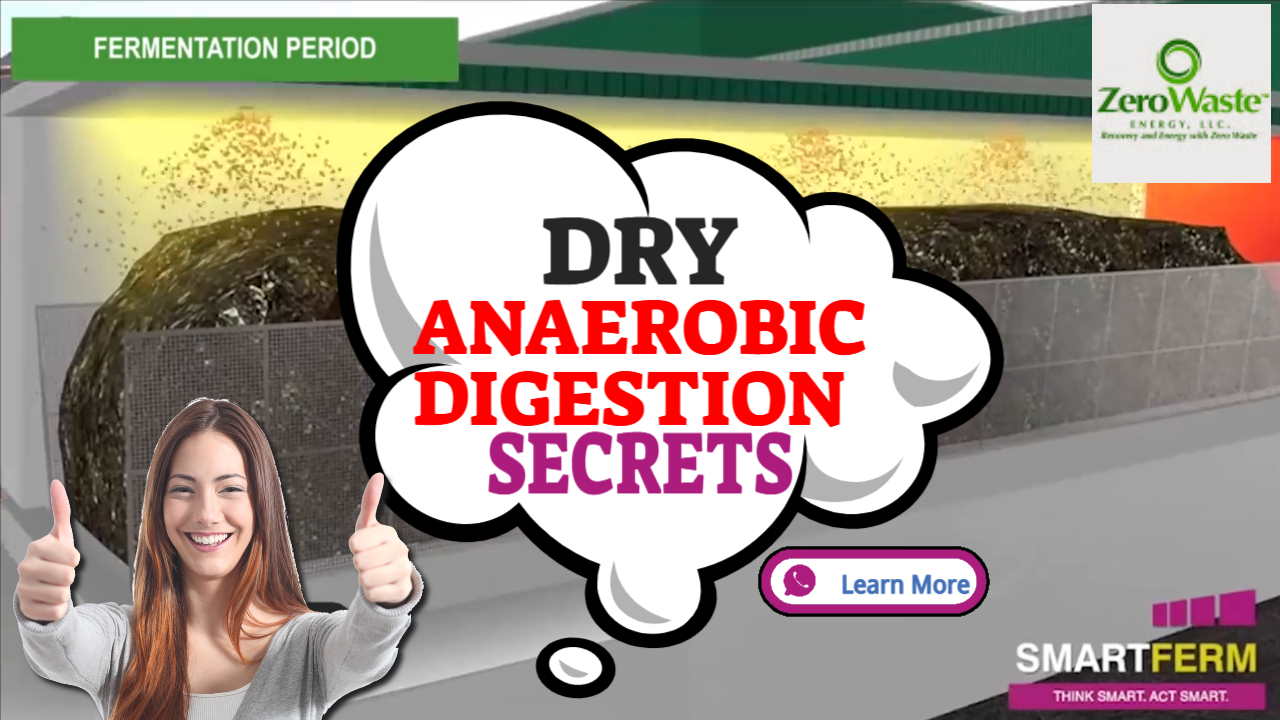
Benefits of Dry Anaerobic Digestion
Lower Retention Times and Reduced Water Demand with Greater Flexibility
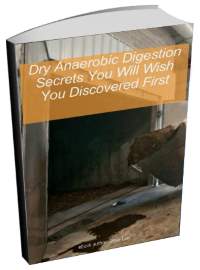
Dry AD plants offer a number of benefits, including wider flexibility in the feedstock sources which can be used.
These include:
- reduced retention times relative to wet AD processes,
- reduced water demand, and
- more opportunities for producing a unique end-product.
The operating process solids content is a key difference between anaerobic digestion (AD) methods for the treatment of municipal and industrial biodegradable wastes:
- Dry AD systems have high operational solids (20% to 40% Total Solids (TS) while,
- Wet AD systems have low total solids (10% to 20% TS).
Source: Bentham Science Journal
2. Output of Additional Chemicals
Dry anaerobic digestion (AD) techniques have recently shown that they can create not only methane but also:
- hydrogen,
- volatile fatty acids (VFAs), and
- ethanol
from:
- municipal solid waste (MSW),
- dewatered sewage sludge,
- animal manure, and
- crop residue.
Dry AD technology has only been used to any degree to commercialize methane synthesis from domestic trash so far. The marketed dry AD facilities are dominated by single-stage dry AD processes that operate in a semicontinuous or continuous mode.
Naturally microbial pretreatment methods (such as stack-pretreatment and aerobic or facultative composting) and co-digestion are practical for dry AD. This is especially for the treatment of carbon and nitrogen-rich organic solid wastes.
These include crop residue and animal manure, to improve biogas production efficiency.
Dry AD systems may produce 121-340 L of CH4 per gramme volatile solids (VS) of the organic portion of MSW (OFMSW) and 51-55 ml H2/g-VS decreased from OFMSW, sewage sludge, and paper and food wastes. This is similar to wet AD systems.
More study on Dry AD is still needed in order to better compete with alternative low-cost treatment and disposal approaches.
New and Increased Dry Feedstocks for the Biogas Industry
Dry anaerobic digestion technology has the potential to open up the biogas industry, making it capable of producing energy from solid manures and other dry crop residues on a continuous basis with a solids content in the digester up to 45%.
Until 2015 anaerobic digestion of animal dung was mostly limited to wet digestion with less than 12% total solids. This has limited biogas generation to dairy and hog enterprises. Or else it necessitated the use of a lot of water to dilute manures with higher solids concentrations.
The DRANCO-Farm dry anaerobic digestion system is now available which continuously processes solid manures and other dry crop residues, with solids content up to 45 percent in the digester.
A high net energy yield per hectare is a must for an energy crop digestion plant to be profitable to operate.
High biomass yields and low energy requirements for plant cultivation, harvesting, and processing are examples of this.
Fertilizer production consumes nearly half of the total energy necessary, with lesser quantities required for machinery (22 percent), transportation fuel (15 percent), and insecticides (13 percent).
Source: Univr – ArticoloRivista – allegato
1. Dry Anaerobic Co-digestion of Seaweed and Solid Cow Manure
Dry anaerobic co-digestion of seaweed and solid cow manure appears to be a potential technique to boost biogas output for coastal biogas facilities near a source of seaweed while also providing extra fertilizer benefits.
On a laboratory scale, two-stage dry anaerobic co-digestion of seaweed and solid cow manure was investigated. When digesting solid cow dung in a leach bed method, a methane yield of 0.14 L/g VS added was produced, and methane yields of 0.16 L/g VS added and 0.11 L/g VS added were obtained from seaweed and seaweed/solid manure in a two-stage anaerobic process, respectively.
The results showed that using the second stage methane reactor for seaweed digestion was helpful, as it produced 83% of the methane while the initial leach bed reactor produced the rest.
In addition, when comparing the co-digestion of seaweed and manure to their separate digestion, the two-stage system was more stable.
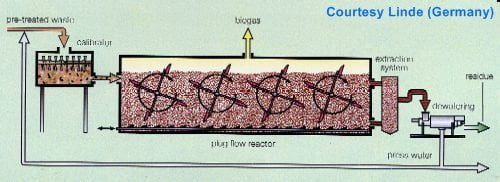 Furthermore, when the materials were co-digested, the initial ammonia inhibition seen with manure digestion and the acidification of the leach bed reactor seen with seaweed digestion were both avoided. The seaweed had a greater Cd level of 0.2 mg Cd/kg TS than the manure, which had a Cd concentration of 0.04 mg Cd/kg TS, posing a risk of exceeding the limit values set for seaweed digestate fertiliser quality.
Furthermore, when the materials were co-digested, the initial ammonia inhibition seen with manure digestion and the acidification of the leach bed reactor seen with seaweed digestion were both avoided. The seaweed had a greater Cd level of 0.2 mg Cd/kg TS than the manure, which had a Cd concentration of 0.04 mg Cd/kg TS, posing a risk of exceeding the limit values set for seaweed digestate fertiliser quality.
Before applying seaweed or a mixture of seaweed and manure digestate to farmland, it is advised that the heavy metal level of the seaweed or a mixture of seaweed and manure digestate be tested.
Source: AJol – Dry
2. Dry Anaerobic Digestion of Wheat Straw and Wool Textile Waste
The dry anaerobic digestion of wheat straw and wool textile waste was studied, and it was shown that co-digesting these two substrates produced larger methane yields than expected.
This means that wool textile waste can now be regarded as a suitable feedstock for anaerobic digestion, expanding the renewable energy potential of waste materials beyond prior predictions.
Wheat straw and wool textile waste were studied for use in the dry anaerobic digestion (AD) process. Different total solid (TS) concentrations ranging from 6% to 30% were used to evaluate dry-AD of the specific substrates as well as co-digestion.
Furthermore, the effects of adding nutrients and cellulose- or protein-degrading enzymes on the AD process' performance were studied.
Methane yields ranged from 0.081 to 0.200 Nm3CH4/kgVS during dry-AD of wheat straw, with the lowest and highest values recorded at 30 and 21 percent TS, respectively. The addition of cellulolytic enzymes to the reactor containing 13 percent TS (0.231 Nm3CH4/kg VS) could greatly boost the yield.
Similarly, the inclusion of the protein-degrading enzyme (0.131 Nm3CH4/kg VS) considerably improved the breakdown of wool textile waste at a TS of 13%.
Furthermore, due to synergetic effects and better nutritional balance, co-digestion of these two substrates produced larger methane yields than the methane potentials computed for the individual fractions at all the examined TS concentrations.
Source: Akia, M., Yazdani, F., Motaee, E., Han, D., Arandiyan, H., 2014. A review on the conversion of biomass to biofuel by nano-catalysts. Biofuel Res. J. 1(1), 16-25. via BiofuelJournal
Dry AD Plant Companies
While researching this article we found the following companies offering this technology:
- Aikan
- Bekon GMBH
- Kompogas
- Linde
- SmartFerm
- Zero Waste.
What is your opinion of these dry anaerobic digestion innovations?
Do you agree that thinking laterally about new biogas feedstocks and co-disposal opportunities, is the way to a sustainable and profitable future for biogas producers, as subsidies for biogas production are reduced?
For AD plant operators making use of other people's waste products, the first to start using novel waste materials, will inevitably have access to the lowest cost feed materials.
Even farm-based AD energy businesses with their own feedstock sources would do well to look at dry anaerobic digestion for extending their in-house facilities for greater flexibility, and also raising their income through synergistic feedstock co-disposal of the sort discussed in our Dry AD “secrets” above.
Terminology: CSR – Completely Stirred Reactor.

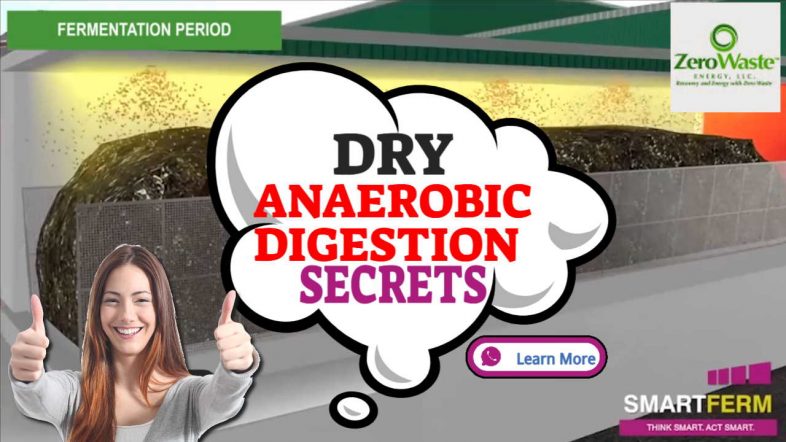

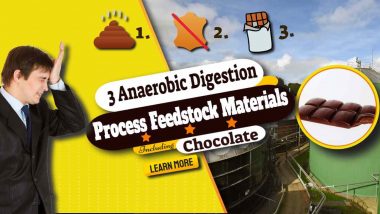

Dry Anaerobic Digestion is an interesting variation on the usual idea of big tanks. I am looking to build dry anaerobic digestion on my farm but although I can find calculations for tank sizes around the internet I have so far failed to find any design criteria for the dry fermentation process. Does it have another name I should be using? I need a calculation for tunnel size per tonne of solid manure, how much water to add and how much is needed to store the innoculum of digestate from previous tunnel batch etc. Can anyone help please. I have a project to start if I can build this myself.
Right away I can answer your question: what is your opinion of these dry anaerobic digestion innovations. In my home country, Poland, I don’t know of any dry waste digesters. I think we may not have them? But, it looks good. You can use old barns for this and do some conversion? This would be good.
We have updated our website software. It should now work fine for all smartphones. If anyone has problems please leave a comment and we will investigate to resolve the difficulty.
Very good article here in this post. Really thank you! come on though – are these really “secrets”.
Cool. A big bono thank you for this blog post.
Spurious “secrets”. I might as well say “Don’t wear seat belts lest you drown in your own urine”? How to claim these as secrets?
Please don’t provide a title which talks about “secrets” unless you really do have a true secret. But, overall not a bad site, if a bit populist for me.